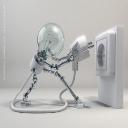Yahoo Answers is shutting down on May 4th, 2021 (Eastern Time) and beginning April 20th, 2021 (Eastern Time) the Yahoo Answers website will be in read-only mode. There will be no changes to other Yahoo properties or services, or your Yahoo account. You can find more information about the Yahoo Answers shutdown and how to download your data on this help page.
Trending News
Couple chemistry questions... bout water and its properties?
1. In your own words, explain hydrogen bonds.
3. Explain why the density of ice at 0°C is less than the density of liquid water at 0°C.
3 Answers
- JohnLv 61 decade agoFavorite Answer
In water the electrons in the bonds between Oxygen and Hydrogen atoms are pulled towards the Oxygen atom because it is more electronegative. This polarises the bond so that the H atom is slightly positive and the O atom is slightly negative.
The slightly positive H atoms and the slightly negative O atoms form a weak, long range form of ionic bond we call a Hydrogen bond. These weak bonds are sufficiently strong to raise the boiling point of water significantly higher than would normally be expected (compare with H2S which should be very similar in properties to water but displays no Hydrogen bonding and is a gas)
When water freezes the crystal structure is slightly distorted by the hydrogen bonds and the molecules of water in ice are held further apart than the molecules of water in the liquid state so Ice is less dense than water at the same temperature.
This effect accounts for the fact that water molecules pack together best at 4oC and so water is densest at this temperature and becomes less dense as it cools towards 0oC.
This is very useful for life in the oceans as the temperature in the deepest parts of the ocean is always 4oC and Ice floats on top of the water leaving liquid beneath for creatures to survive.
- 1 decade ago
hydrogen bonds are those shared hydrogen and that of the 3 highly electronegativee elements nitrogen, oxygen and florine. Hydrogen is essentially a proton when shared with an oxygen molecule as this occupies one of two valency places. This then makes the molecule polar (+ve and -ve ends) in this case oxygen is -ve and hydrogen +ve. The +ve hydrogen is attracted to the negativity of the paired electrons of the oxygen to form a hydrogen bond. This is stronger than instantaneous induced dipole forces and give water its properties.
When environmental factors change the temperature to 0C, hydrogen bonds expand moving the molecules further apart thus decreasing the density allowing ice to float.
- jamshedLv 44 years ago
water = hydrogen + oxygen * the two H and O are gases, water is liquid * (write the homes of beverages/gases then you definately would be completed with atleast 3 or 4 mor factors) then ur completed =)



